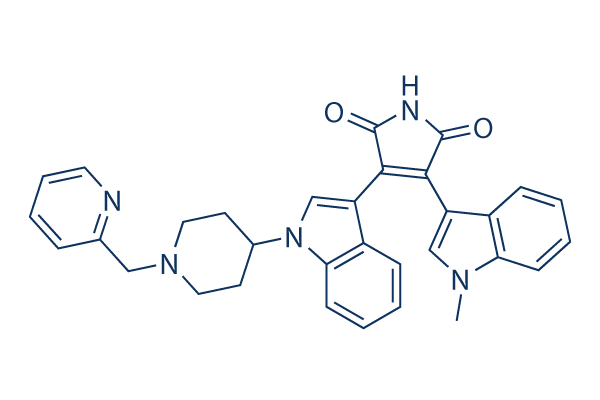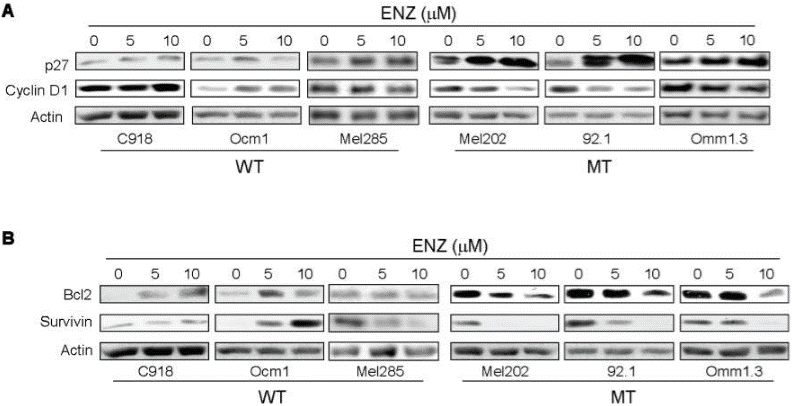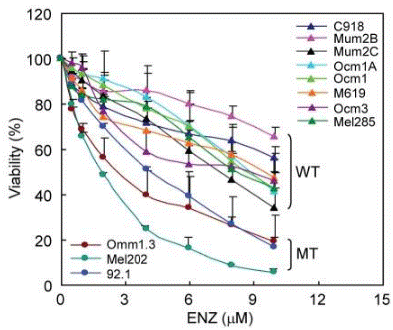
- Bioactive Compounds
- By Signaling Pathways
- PI3K/Akt/mTOR
- Epigenetics
- Methylation
- Immunology & Inflammation
- Protein Tyrosine Kinase
- Angiogenesis
- Apoptosis
- Autophagy
- ER stress & UPR
- JAK/STAT
- MAPK
- Cytoskeletal Signaling
- Cell Cycle
- TGF-beta/Smad
- Compound Libraries
- Popular Compound Libraries
- Customize Library
- Clinical and FDA-approved Related
- Bioactive Compound Libraries
- Inhibitor Related
- Natural Product Related
- Metabolism Related
- Cell Death Related
- By Signaling Pathway
- By Disease
- Anti-infection and Antiviral Related
- Neuronal and Immunology Related
- Fragment and Covalent Related
- FDA-approved Drug Library
- FDA-approved & Passed Phase I Drug Library
- Preclinical/Clinical Compound Library
- Bioactive Compound Library-I
- Bioactive Compound Library-Ⅱ
- Kinase Inhibitor Library
- Express-Pick Library
- Natural Product Library
- Human Endogenous Metabolite Compound Library
- Alkaloid Compound LibraryNew
- Angiogenesis Related compound Library
- Anti-Aging Compound Library
- Anti-alzheimer Disease Compound Library
- Antibiotics compound Library
- Anti-cancer Compound Library
- Anti-cancer Compound Library-Ⅱ
- Anti-cancer Metabolism Compound Library
- Anti-Cardiovascular Disease Compound Library
- Anti-diabetic Compound Library
- Anti-infection Compound Library
- Antioxidant Compound Library
- Anti-parasitic Compound Library
- Antiviral Compound Library
- Apoptosis Compound Library
- Autophagy Compound Library
- Calcium Channel Blocker LibraryNew
- Cambridge Cancer Compound Library
- Carbohydrate Metabolism Compound LibraryNew
- Cell Cycle compound library
- CNS-Penetrant Compound Library
- Covalent Inhibitor Library
- Cytokine Inhibitor LibraryNew
- Cytoskeletal Signaling Pathway Compound Library
- DNA Damage/DNA Repair compound Library
- Drug-like Compound Library
- Endoplasmic Reticulum Stress Compound Library
- Epigenetics Compound Library
- Exosome Secretion Related Compound LibraryNew
- FDA-approved Anticancer Drug LibraryNew
- Ferroptosis Compound Library
- Flavonoid Compound Library
- Fragment Library
- Glutamine Metabolism Compound Library
- Glycolysis Compound Library
- GPCR Compound Library
- Gut Microbial Metabolite Library
- HIF-1 Signaling Pathway Compound Library
- Highly Selective Inhibitor Library
- Histone modification compound library
- HTS Library for Drug Discovery
- Human Hormone Related Compound LibraryNew
- Human Transcription Factor Compound LibraryNew
- Immunology/Inflammation Compound Library
- Inhibitor Library
- Ion Channel Ligand Library
- JAK/STAT compound library
- Lipid Metabolism Compound LibraryNew
- Macrocyclic Compound Library
- MAPK Inhibitor Library
- Medicine Food Homology Compound Library
- Metabolism Compound Library
- Methylation Compound Library
- Mouse Metabolite Compound LibraryNew
- Natural Organic Compound Library
- Neuronal Signaling Compound Library
- NF-κB Signaling Compound Library
- Nucleoside Analogue Library
- Obesity Compound Library
- Oxidative Stress Compound LibraryNew
- Plant Extract Library
- Phenotypic Screening Library
- PI3K/Akt Inhibitor Library
- Protease Inhibitor Library
- Protein-protein Interaction Inhibitor Library
- Pyroptosis Compound Library
- Small Molecule Immuno-Oncology Compound Library
- Mitochondria-Targeted Compound LibraryNew
- Stem Cell Differentiation Compound LibraryNew
- Stem Cell Signaling Compound Library
- Natural Phenol Compound LibraryNew
- Natural Terpenoid Compound LibraryNew
- TGF-beta/Smad compound library
- Traditional Chinese Medicine Library
- Tyrosine Kinase Inhibitor Library
- Ubiquitination Compound Library
-
Cherry Picking
You can personalize your library with chemicals from within Selleck's inventory. Build the right library for your research endeavors by choosing from compounds in all of our available libraries.
Please contact us at [email protected] to customize your library.
You could select:
- Antibodies
- Bioreagents
- qPCR
- 2x SYBR Green qPCR Master Mix
- 2x SYBR Green qPCR Master Mix(Low ROX)
- 2x SYBR Green qPCR Master Mix(High ROX)
- Protein Assay
- Protein A/G Magnetic Beads for IP
- Anti-DYKDDDDK Tag magnetic beads
- Anti-DYKDDDDK Tag Affinity Gel
- Anti-Myc magnetic beads
- Anti-HA magnetic beads
- Poly DYKDDDDK Tag Peptide lyophilized powder
- Protease Inhibitor Cocktail
- Protease Inhibitor Cocktail (EDTA-Free, 100X in DMSO)
- Phosphatase Inhibitor Cocktail (2 Tubes, 100X)
- Cell Biology
- Cell Counting Kit-8 (CCK-8)
- Animal Experiment
- Mouse Direct PCR Kit (For Genotyping)
- New Products
- Contact Us
Enzastaurin
Synonyms: LY317615
Enzastaurin is a potent PKCβ selective inhibitor with IC50 of 6 nM in cell-free assays, 6- to 20-fold selectivity against PKCα, PKCγ and PKCε. Phase 3.

Enzastaurin Chemical Structure
CAS: 170364-57-5
Selleck's Enzastaurin has been cited by 59 publications
Purity & Quality Control
Batch:
Purity:
99.98%
99.98
Other PKC Products
Related compound libraries
Choose Selective PKC Inhibitors
Cell Data
| Cell Lines | Assay Type | Concentration | Incubation Time | Formulation | Activity Description | PMID |
|---|---|---|---|---|---|---|
| SJ-GBM2 | qHTS assay | qHTS of pediatric cancer cell lines to identify multiple opportunities for drug repurposing: Primary screen for SJ-GBM2 cells | 29435139 | |||
| A673 | qHTS assay | qHTS of pediatric cancer cell lines to identify multiple opportunities for drug repurposing: Primary screen for A673 cells | 29435139 | |||
| NB-EBc1 | qHTS assay | qHTS of pediatric cancer cell lines to identify multiple opportunities for drug repurposing: Primary screen for NB-EBc1 cells | 29435139 | |||
| Saos-2 | qHTS assay | qHTS of pediatric cancer cell lines to identify multiple opportunities for drug repurposing: Primary screen for Saos-2 cells | 29435139 | |||
| LAN-5 | qHTS assay | qHTS of pediatric cancer cell lines to identify multiple opportunities for drug repurposing: Primary screen for LAN-5 cells | 29435139 | |||
| OHS-50 | qHTS assay | qHTS of pediatric cancer cell lines to identify multiple opportunities for drug repurposing: Primary screen for OHS-50 cells | 29435139 | |||
| MG 63 (6-TG R) | qHTS assay | qHTS of pediatric cancer cell lines to identify multiple opportunities for drug repurposing: Primary screen for MG 63 (6-TG R) cells | 29435139 | |||
| Click to View More Cell Line Experimental Data | ||||||
Biological Activity
| Description | Enzastaurin is a potent PKCβ selective inhibitor with IC50 of 6 nM in cell-free assays, 6- to 20-fold selectivity against PKCα, PKCγ and PKCε. Phase 3. | ||||||||
|---|---|---|---|---|---|---|---|---|---|
| Targets |
|
| In vitro | ||||
| In vitro | Enzastaurin application results in a marked dose-dependent inhibition of growth in all MM cell lines investigated, including MM.1S, MM.1R, RPMI 8226 (RPMI), RPMI-Dox40 (Dox40), NCI-H929, KMS-11, OPM-2, and U266, with IC50 from 0.6-1.6 μM. Enzastaurin direct impacts human tumor cells, inducing apoptosis and suppressing proliferation in cultured tumor cells. Enzastaurin also suppresses the phosphorylation of GSK3βser9, ribosomal protein S6S240/244, and AKTThr308 while having no direct effect on VEGFR phosphorylation. [1] Enzastaurin increases apoptosis in malignant lymphocytes of CTCL. When combined with GSK3 inhibitors, enzastaurin demonstrated an enhancement of cytotoxicity levels. Treatment with a combination of enzastaurin and the GSK3 inhibitor AR-A014418 led to increased levels of β-catenin total protein and β-catenin-mediated transcription. Blocking of β-catenin-mediated transcription or small hairpin RNA (shRNA) knockdown of β-catenin induced the same cytotoxic effects as that of enzastaurin plus AR-A014418. Additionally, treatment with enzastaurin and AR-A014418 decreased the mRNA levels and surface expression of CD44. [2] | |||
|---|---|---|---|---|
| Kinase Assay | Kinase inhibition assays | |||
| The inhibition of PKCβII, PKCα, PKCε, or PKCγ activity by enzastaurin is determined using a filter plate assay format measuring 33P incorporation into myelin basic protein substrate. Reactions are done in 100 μL reaction volumes in 96-well polystyrene plates with final conditions as follows: 90 mM HEPES (pH 7.5), 0.001% Triton X-100, 4% DMSO, 5 mM MgCl2, 100 μM CaCl2, 0.1 mg/mL phosphatidylserine, 5 μg/mL diacetyl glyerol, 30 μM ATP, 0.005 μCi/μL 33ATP, 0.25 mg/mL myelin basic protein, serial dilutions of enzastaurin (1-2,000 nM), and recombinant human PKCβII, PKCα, PKCε, or PKCγ enzymes (390, 169, 719, or 128 pM, respectively). Reactions are started by addition of the enzyme and incubated at room temperature for 60 minutes. They are then quenched with 10% H3PO4, transferred to multiscreen anionic phosphocellulose 96-well filter plates, incubated for 30 to 90 minutes, filtered and washed with 4 volumes of 0.5% H3PO4 on a vacuum manifold. Scintillation cocktail is added and plates are read on a Microbeta scintillation counter. IC50 values are determined by fitting a three-variable logistic equation to the 10-point dose-response data using ActivityBase 4.0. | ||||
| Cell Research | Cell lines | HCT116 and U87MG cells | ||
| Concentrations | 0.3-4 μM | |||
| Incubation Time | 72 hours | |||
| Method | Induction of apoptosis by enzastaurin is measured by nucleosomal fragmentation and terminal deoxynucleotidyl transferase-mediated nick-end labeling (TUNEL) and staining in HCT116 and U87MG cell lines. Briefly, 5 × 103 cells are plated per well in 96-well plates (1% FBS-supplemented media conditions), incubated with or without Enzastaurin for 48 to 72 hours. The absorbance values are normalized to those from control-treated cells to derive a nucleosomal enrichment factor at all concentrations as per the manufacturer's protocol. The concentrations studied ranges from 0.1 to 10 μM. In situ TUNEL staining is assayed with the In situ Cell Death Detection, Fluorescein kit. Cells (7.5 ?104) are plated per well in 6-well plates and incubated 72 hours in 1% FBS-supplemented media ?Enzastaurin. Fluorescein-labeled DNA strand breaks are detected with the BD epics flow cytometer. Ten thousand, single-cell, FITC-staining events are collected for each test. |
|||
| Experimental Result Images | Methods | Biomarkers | Images | PMID |
| Western blot | p27 / Cyclin D1 / Bcl-2 / Survivin p-ERK / ERK / p-AKT / AKT PKCα / PKCβ / PKCδ / PKCε / PKCθ / p-PKCε / p-PKCθ p-eIF2a / eIF2a / p-ATF2 / ATF2 / CHOP / p21 / ATF6 / IRE1α |

|
22253748 | |
| Growth inhibition assay | Cell viability |

|
22253748 | |
| In Vivo | ||
| In vivo | Treatment of xenografts with Enzastaurin and radiation produced greater reductions in density of microvessels than either treatment alone. The decrease in microvessel density corresponded to delayed tumor growth. [3] | |
|---|---|---|
| Animal Research | Animal Models | Athymic nude mice; Mouse besring human MM tumors |
| Dosages | 75 mg/kg twice daily; 30 mg/kg twice daily | |
| Administration | By gavage | |
| NCT Number | Recruitment | Conditions | Sponsor/Collaborators | Start Date | Phases |
|---|---|---|---|---|---|
| NCT03263026 | Completed | Diffuse Large B-Cell Lymphoma | Denovo Biopharma LLC | March 20 2018 | Phase 3 |
| NCT01432951 | Completed | Solid Tumor|Lymphoma Malignant | Eli Lilly and Company | November 2011 | Phase 1 |
| NCT01388335 | Completed | Solid Tumor|Lymphoma Malignant | Eli Lilly and Company | August 2011 | Phase 1 |
| NCT00744991 | Completed | Cutaneous T-Cell Lymphoma | Eli Lilly and Company | September 2008 | Phase 2 |
| NCT00709995 | Completed | Metastatic Renal Cell Carcinoma | Eli Lilly and Company | June 30 2008 | Phase 2 |
Chemical lnformation & Solubility
| Molecular Weight | 515.61 | Formula | C32H29N5O2 |
| CAS No. | 170364-57-5 | SDF | Download Enzastaurin SDF |
| Smiles | CN1C=C(C2=CC=CC=C21)C3=C(C(=O)NC3=O)C4=CN(C5=CC=CC=C54)C6CCN(CC6)CC7=CC=CC=N7 | ||
| Storage (From the date of receipt) | |||
|
In vitro |
DMSO : 14 mg/mL ( (27.15 mM); Moisture-absorbing DMSO reduces solubility. Please use fresh DMSO.) Water : Insoluble Ethanol : Insoluble |
Molecular Weight Calculator |
|
In vivo Add solvents to the product individually and in order. |
In vivo Formulation Calculator |
||||
Preparing Stock Solutions
Molarity Calculator
In vivo Formulation Calculator (Clear solution)
Step 1: Enter information below (Recommended: An additional animal making an allowance for loss during the experiment)
mg/kg
g
μL
Step 2: Enter the in vivo formulation (This is only the calculator, not formulation. Please contact us first if there is no in vivo formulation at the solubility Section.)
% DMSO
%
% Tween 80
% ddH2O
%DMSO
%
Calculation results:
Working concentration: mg/ml;
Method for preparing DMSO master liquid: mg drug pre-dissolved in μL DMSO ( Master liquid concentration mg/mL, Please contact us first if the concentration exceeds the DMSO solubility of the batch of drug. )
Method for preparing in vivo formulation: Take μL DMSO master liquid, next addμL PEG300, mix and clarify, next addμL Tween 80, mix and clarify, next add μL ddH2O, mix and clarify.
Method for preparing in vivo formulation: Take μL DMSO master liquid, next add μL Corn oil, mix and clarify.
Note: 1. Please make sure the liquid is clear before adding the next solvent.
2. Be sure to add the solvent(s) in order. You must ensure that the solution obtained, in the previous addition, is a clear solution before proceeding to add the next solvent. Physical methods such
as vortex, ultrasound or hot water bath can be used to aid dissolving.
Tech Support
Answers to questions you may have can be found in the inhibitor handling instructions. Topics include how to prepare stock solutions, how to store inhibitors, and issues that need special attention for cell-based assays and animal experiments.
Tel: +1-832-582-8158 Ext:3
If you have any other enquiries, please leave a message.
* Indicates a Required Field
Tags: buy Enzastaurin | Enzastaurin supplier | purchase Enzastaurin | Enzastaurin cost | Enzastaurin manufacturer | order Enzastaurin | Enzastaurin distributor







































